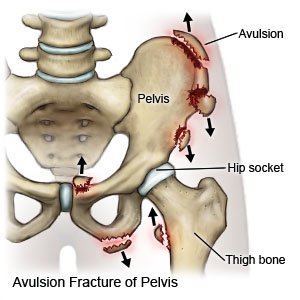Pelvic Avulsion Fractures in Adults
Medically reviewed by Drugs.com. Last updated on Aug 4, 2025.
A pelvic avulsion fracture occurs when a part of a hip bone breaks and tears away. This happens when a muscle or tendon connected to the hip bone suddenly tightens so hard that it pulls off part of the bone.
 |
DISCHARGE INSTRUCTIONS:
Call your local emergency number (911 in the US) if:
- You feel lightheaded, short of breath, and have chest pain.
- You cough up blood.
Return to the emergency department if:
- Your leg feels warm, tender, and painful. It may look swollen and red.
- You have increased swelling, pain, or redness in your hip.
- You have trouble moving your leg or foot.
- Your leg feels numb.
Call your doctor or orthopedist if:
- You have a fever.
- You have new symptoms.
- You have questions or concerns about your condition or care.
Medicines:
You may need any of the following:
- Prescription pain medicine may be given. Ask your healthcare provider how to take this medicine safely. Some prescription pain medicines contain acetaminophen. Do not take other medicines that contain acetaminophen without talking to your healthcare provider. Too much acetaminophen may cause liver damage. Prescription pain medicine may cause constipation. Ask your healthcare provider how to prevent or treat constipation.
- NSAIDs help decrease swelling and pain or fever. This medicine is available with or without a doctor's order. NSAIDs can cause stomach bleeding or kidney problems in certain people. If you take blood thinner medicine, always ask your healthcare provider if NSAIDs are safe for you. Always read the medicine label and follow directions.
- Acetaminophen decreases pain and fever. It is available without a doctor's order. Ask how much to take and how often to take it. Follow directions. Read the labels of all other medicines you are using to see if they also contain acetaminophen, or ask your doctor or pharmacist. Acetaminophen can cause liver damage if not taken correctly.
- Take your medicine as directed. Contact your healthcare provider if you think your medicine is not helping or if you have side effects. Tell your provider if you are allergic to any medicine. Keep a list of the medicines, vitamins, and herbs you take. Include the amounts, and when and why you take them. Bring the list or the pill bottles to follow-up visits. Carry your medicine list with you in case of an emergency.
Limit activity as directed:
Get plenty of rest while your fracture heals. When the pain decreases, begin normal, slow movements. Slowly start to do more as directed. Rest when you feel it is needed.
Ice:
Apply ice on your hip for 15 to 20 minutes every hour or as directed. Use an ice pack, or put crushed ice in a plastic bag. Cover it with a towel before you apply it. Ice helps prevent tissue damage and decreases swelling and pain.
Walking devices:
You may need to use crutches or a walker until your fracture heals. Ask for more information about how to use these walking devices if needed.
Physical therapy:
A physical therapist may teach you exercises to strengthen your hip and legs after the pain is gone.
Follow up with your doctor or orthopedist as directed:
Write down your questions so you remember to ask them during your visits.
© Copyright Merative 2025 Information is for End User's use only and may not be sold, redistributed or otherwise used for commercial purposes.
The above information is an educational aid only. It is not intended as medical advice for individual conditions or treatments. Talk to your doctor, nurse or pharmacist before following any medical regimen to see if it is safe and effective for you.
Learn more about Pelvic Avulsion Fractures
Care guides
Further information
Always consult your healthcare provider to ensure the information displayed on this page applies to your personal circumstances.
